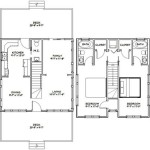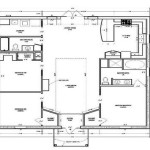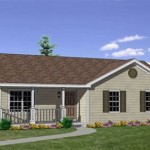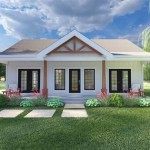Pier and Beam Home Plans: A Guide to Elevated Living
Pier and beam home plans offer a unique and versatile approach to residential construction. These homes are elevated on piers, creating a raised foundation that provides several benefits, including improved drainage, natural ventilation, and protection from pests. In this article, we will explore the advantages and considerations of pier and beam home plans.
Benefits of Pier and Beam Home Plans
1. Improved Drainage: The elevated foundation of a pier and beam home allows for better drainage than traditional concrete slabs or basements. This is especially beneficial in areas with heavy rainfall or poor soil conditions, as it prevents water from pooling around the home and causing damage.
2. Natural Ventilation: The open space beneath the home promotes natural airflow, reducing the need for artificial ventilation. This can help improve indoor air quality and reduce energy costs.
3. Pest Protection: The elevated nature of these homes creates a physical barrier between the ground and the living space, making them less susceptible to pests like termites and rodents.
4. Flexibility in Design: Pier and beam homes offer greater flexibility in design compared to other construction methods. The elevated foundation allows for open floor plans and the easy incorporation of sloping rooflines and balconies.
5. Energy Efficiency: The elevated structure allows for cross ventilation, which can help reduce the need for air conditioning in warmer climates. Additionally, the open space beneath the home can act as a thermal buffer, reducing heat transfer between the ground and the interior.
Considerations for Pier and Beam Home Plans
1. Site Conditions: Pier and beam homes are best suited for flat or gently sloping sites with well-drained soil. Steep slopes or unstable soil conditions may require additional foundation work.
2. Moisture Control: Proper moisture control is essential to prevent damage to the piers and beams. This includes installing vapor barriers and ensuring that the crawl space remains well-ventilated.
3. Pier and Beam Materials: Piers and beams can be made from various materials, such as concrete, steel, or wood. The choice of material depends on factors like durability, cost, and availability.
4. Floor System: Pier and beam homes typically have raised floors, which can be made from wood, plywood, or concrete. The type of flooring chosen should be compatible with the foundation system and provide adequate structural support.
5. Access to Utilities: It is important to ensure easy access to utilities such as plumbing, electrical, and HVAC systems. Careful planning and coordination are required to route these utilities under or around the elevated home.
Conclusion
Pier and beam home plans offer a unique and advantageous approach to residential construction. These homes provide numerous benefits, including improved drainage, natural ventilation, pest protection, and design flexibility. However, it is important to consider the site conditions, moisture control measures, material selection, and access to utilities before opting for a pier and beam home. By carefully planning and addressing these considerations, homeowners can enjoy the many advantages of elevated living.

4 Bedroom Pier And Beam House Plans 228 M2 Pavilion Nfloorplans

Residential Floor Plans American Post Beam Homes Modern Solutions To Traditional Living

Pin Page

Residential Floor Plans American Post Beam Homes Modern Solutions To Traditional Living

How To Modify A Standard Post And Pier Foundation Plan

Talani Beach Vacation Home Plan 069d 0116 House Plans And More

I M Building A Not So Tiny House Part 1 Permits Site Prep Crafted Work

Pier And Beam Foundation Construction Design

Beach House Plan On Post And Pier Foundation 62795dj Architectural Designs Plans

House Plans








